Scott Walchek founded and successfully exited four tech start-ups—and now he’s turned his sights to insurtech. In this podcast episode, he shares how and why Trov has made several micro-pivots since its launch in 2012—and what he’s learned about insurtech in that time.
Highlights
- Scott Walchek is a serial entrepreneur who’s successfully exited four technology start-ups. In this interview, he highlights the micro-pivots that have gotten Trov to where it is today.
- Several considerations led to the company sunsetting its direct-to-consumer, on-demand insurance application—including high customer acquisition cost (CAC), the challenges of being a new entrant in an entrenched “trust industry” and upside-down unit economics.
- By collecting data in real time and leveraging the Internet of Things, Trov aims to enable new consumer behaviors and cover new risks—such as partnering with Waymo to cover autonomous vehicles, or providing dynamic insurance pricing for car-sharing services like Free2Move.
Welcome back
In season two of the Accenture Insurance Influencers podcast, we’re taking a deep dive into the world of insurtech. Every two weeks, we’ll share a new conversation with a VC, insurtech founder or thought leader. What are their views on the current and future state of the industry? How are they creating change for themselves?
The art of the pivot, with Scott Walchek
We’re kicking off season two with an interview with Scott Walchek from Trov. You may be familiar with Trov as leaders in the on-demand insurance space: swipe right to insure your DSLR or skis before your vacation, and swipe left to turn it off when you get back.
As we learn in this episode, Trov has pivoted from its direct-to-consumer insurance app. Instead, it’s taking that same capability and applying it to self-driving cars, notably in partnership with Waymo, the autonomous vehicle developer. In this interview, Scott reveals what it really takes to be a start-up founder and entrepreneur; the role of data, vision and serendipity in a start-up’s story; and the art and science of making a graceful pivot.
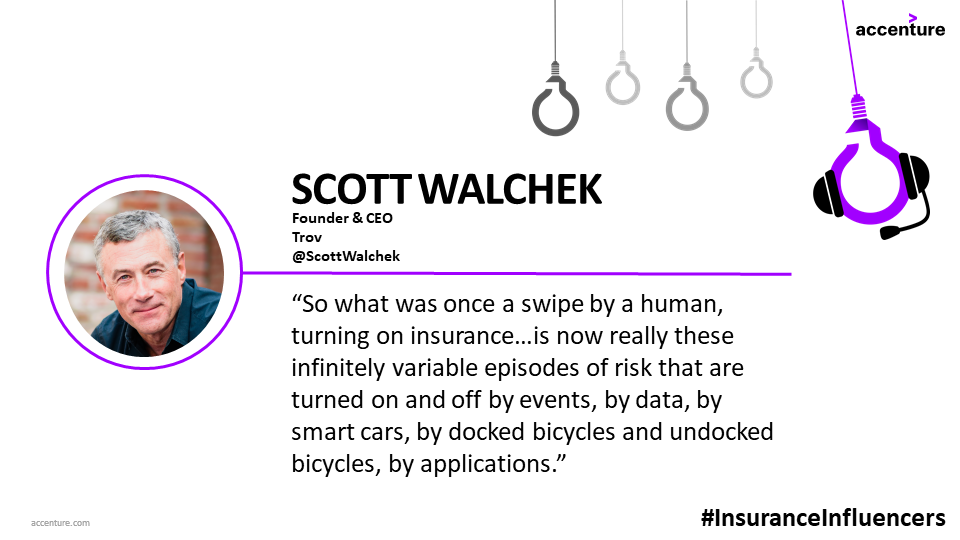
The following transcript has been edited for length and clarity.
Welcome back to the Accenture Insurance Influencers podcast. I’m Eagranie Yuh and today I’m speaking with Scott Walchek, the founder and CEO of Trov. Scott has founded and successfully exited several tech start-ups, and was the co-lead investor and founding director of Baidu. Scott, welcome to the podcast.
Thanks. Great to be here.
So let’s start with Trov. Can you give us a quick background on Trov and what it does?
So back in 2012 when I started this, it was around the idea that there’s enormous value locked up in the information about the things that people own. The idea was, if we could give people agency over that information, if we could somehow collect that information on behalf of others and store it in a personal repository—we called it a Trov, like a treasure trove—then we could we could really unlock value within four markets, one of which was insurance.
That’s now morphed into us becoming one of the world’s leading insurance technology platforms, enabling the new ways that people live, people move and people work.
What would be an example of data that’s locked up in something? Say my computer: what data is locked up in there and what do you envision that could do for me if it’s unlocked?
So in the beginning the idea was that the thing I own, or the metadata about that item, for example your laptop, that has a lot of either personal value or financial value. We were thinking, “Well, there’s all this value in the things that people own, why not be able to track those values in real time?” For example, you could track it as a separate asset class, thereby impacting finance and credit. Create a new way for people to take advantage of that data.
We’ve moved a lot since then. First, we pointed the idea at the high-net-worth space, thinking that they were the ones who were going to benefit most because they’re the ones that with the most to lose. It then became evident to us that trying to scale a business to that, globally, was really hard, very expensive.
We came to the obvious, now in hindsight, the obvious understanding about a new generation––the digital native. Everything that they own, everything that they use, whether they own it or have access to it, has some sort of digital exhaust associated with it. And we could insert ourselves into digital exhaust, remove the friction around helping people collect this information to put into their Trov, and then we could give them ways to take advantage of it.
Like—here comes the big bridge—like helping them protect just what they wanted, whenever they wanted, for whatever duration they needed. So there’s the bridge.
I think one of the interesting things about Trov is this idea of a digital native maybe not having art or a flashy car like high-net-worth customers, but having a camera or laptop or smartphone. To them, those are treasured possessions. And I’ve heard you talk about Trov in terms of the atomization of the insurance of items. Can you talk about that a little bit?
Yeah. So the most obvious application was if we’re helping people discreetly manage some of their most prized possessions, particularly for the digital native that has fewer things and they care more about access than they do ownership, then the things that they own are really important to their whole lifestyle. (And by the way, this happened around 2014, well before insurtech was a thing.)
And the proposition was, “Why don’t we align ourselves with the evident way that the digital native is navigating their interactions with goods and services?” So on-demand, in whatever duration, whatever time of day, whether it’s entertainment or banking or food services.
And we said, “What’s preventing us from doing that with insurance?” Hence was born this app that we said had to be on-demand. That is, you could turn on insurance—real insurance like loss, damage, theft—turn it on anywhere in the world for anything, my laptop, my camera, what have you. And then only allow it to be turned on for the times that I needed it, which was of course completely antithetical to traditional insurance, which was protecting things I don’t care about, when I don’t need them. You know, big blanket policies and such.
We said it had to be as simple as Tinder, as beautiful as Airbnb, and it had to be all accessed on a mobile device, from engagement all the way through claims adjudication. And so that created this really valuable artifact of this underlying technology that we now call the atomization or the atomic disassembly of the insurance value chain.
And believe me, if we had known how complex this was going to be—this insurance value chain from engagement through pricing through policy management, customer management, claims adjudication, claims lodging, business intelligence, what have you—I’m not sure we would have done it from the beginning.

This technology to support that unique moment of on-demand insurance for micro-durations, that really created these building blocks we call the atoms of insurance. Beyond that the application within our consumer and our DTC [direct to consumer], those building blocks are now being reassembled into these more interesting and more dynamic use cases within insurance. Let me give you some examples.
So an average Uber ride is 16 minutes, an average scooter ride is seven minutes, the average time that an individual spends using an Airbnb is just under three days, the average tasker from TaskRabbit or similar services is about two and a half hours. The average Trov user was protecting a camera for just under three days. We call these infinitely variable episodes of risk, and they’re entirely keeping with the new ways, the new consumer platforms that have been enabled by the ubiquity of connected technology.
Risk isn’t changing. People are still breaking things, losing things, getting hurt. But the way that risk is being presented is really new. And that’s these atoms of insurance, the atoms of the insurance value chain, that Trov has built, that are now being applied to specifically address those infinitely variable episodes of risk that are modified or triggered by data or events.
So what was once a swipe by a human, turning on insurance: a swipe right to turn on, turn off with a swipe left, for whatever duration of time––we call it on-demand micro-duration––is now really these infinitely variable episodes of risk that are turned on and off by events, by data, by smart cars, by docked bicycles and undocked bicycles, by applications. It’s a very interesting proposition for the world that has changed because of connected technology.
I saw that recently, Trov expanded from the core offering—your on-demand service—and into other lines of business. Can you talk a little bit about those?
Yeah, sure. It’s a go-to-market strategy more than it is lines of business because we’re still serving the core, which is helping incumbent insurers be relevant in the future and helping emerging consumer platforms. And not that these are our customers, but you will understand like the Waymos, like the Ubers, like the Airbnbs, like the TaskRabbits and GoSpotChecks of the world. Each of them representing a different one of these columns of live, work, and move.
And our business is essentially around a B2B or a B2B2C approach. The B2B2C is on the incumbent side and I’ll talk about that in a minute. And the B2B is a more SaaS model empowering these consumer platforms.
So what’s not in our business going forward, after we’ve talked about this application that people love—the on-demand micro-duration for single items—we’re now sunsetting that around the world. We’re doing that because we’ve gleaned all that we need to from that user engagement, and we’ve built all the superstructure that supports that unique on-demand micro-duration (which we now call event-triggered and infinitely variable episodes of risk). And as we talked about before, those atomic sub-particles are being reassembled to address these new opportunities.
So what does that look like? If you think about Trov, you can think about us sitting between a technological bridge for billions of dollars of capacity, meeting billions of dollars of demand for insurance coverages.
On that first side of that bridge, with capacity, are the incumbents, and the incumbents are struggling––they’re doing fine––but they know the opportunities that for them, going forward, are around providing capacity for these emerging risks, and they’re facing a Janus moment right now.
That’s Janus, the mythical god that has two faces, where half is looking forward and half is looking backward. The backward-facing folks are trying to modernize their core platforms, bring them into the 21st century. And all their IT resources are going there. But the forward-looking face of the insurance Janus, if you would, those folks are analyzing how they can remain relevant to an emerging consumer base that lives their lives on smart devices, has new consumer behaviors and expectations, and these new risks presented by the new ways that people live, work and move.
We are providing home and auto products that are full-stack, white-label products. They’re being brought to market by others––and I can’t talk about these until they’re public––but around the world, insurance incumbents and banks and other financial service providers who are offering insurance to their constituents, are private labeling Trov’s renters and home products and our personal auto products––none of which anyone has seen publicly yet––that are built upon many of the core components that we have invested in before.
On the other side of that bridge, with demand, are the consumer platforms like Waymo or Peugeot. We provide technology capability that recognizes the data, takes in data, and then modifies coverages to make insurance much more efficient. That makes these consumer platforms and their insurance managers much more efficient around risk identification and risk mitigation.
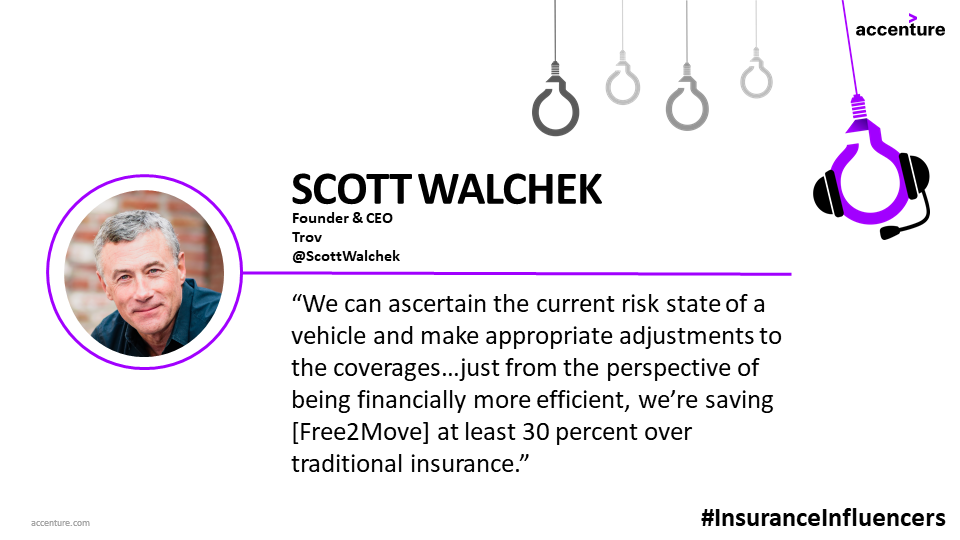
A great example is Peugeot, who relaunched their US brand in a car share model with several hundred cars in Washington D.C., and now with several thousand throughout the territory. They’re called Free2Move. You have a phone app, you walk up to a car, you type in a code and you open the door. And then you can drive away with a car, and you can use that car for a minute, an hour, a day, a week, a month–– whatever it might be. And those variations of time are key to being efficient.
Free2Move will tell you that they went to the insurance world, and the insurance world said, “We’ll give you a policy that lasts a year, but it’s a standard price of X-number of thousands of dollars per car.”
They came to Trov and Trov said, “No, wait a minute––these are connected cars that are giving off lots of data every second. If you gave us that data, we could tell you the state of the car––if it’s being driven or if it’s being stationary. We could also tell you who’s driving it, whether it’s one of your maintenance people or whether it’s a consumer.” And because of the matrix of varying coverages and varying risk states, the coverage footprint becomes much more efficient and therefore less expensive.
So we get 12 fields of data every 10 seconds from every car, and from that data we can ascertain the current risk state of that vehicle and make appropriate adjustments to the coverages. And they’re telling us, just from the perspective of being financially more efficient, that we’re saving them at least 30 percent over traditional insurance.
Holy cow. I have lots of questions. How much time do you have today, Scott?
And I’ll tell you a story, but I don’t want to interrupt the…
Go for it. I want to hear the story.
This was back in I think 2015; no, probably 2016/17. We are a remote company, about 85 people, 90 people now. And we have a bunch of folks around the world and it’s hard to manage it. So we try to get them together once a year, for a week of vision casting and engagement and setting objectives, what have you, see how we’re doing.
And this was July, so about halfway through the year, and we’d set four or five—let’s call it five—audacious goals. And I had just done the keynote: where we are and how we’re doing; onward troops, we’re doing great, don’t get off track. Here are the five things we’re doing this year.
That night I was invited to speak at a at a dinner down in Silicon Valley with a bunch of execs, and I sat next to Loren Nickel, who was the head of risk across Alphabet at the time, with Google. And he heard my story about Trov. And the next day he called me and said, “Hey I got some thoughts. Can you come meet me?”
So I go down and meet with him, I think that was a Thursday. And he says, “I’ve been working with the insurance world around our robot cars, the Waymo platform,” which is now the leading autonomous vehicle operating system in the world, and he said, “We’ve been trying to understand how the current incumbent insurers can protect these,” and here, he didn’t use these words, but in Trov-speak, “these episodes of risk that are presented when a passenger is an autonomous vehicle.”
And he said, “Hearing your story, can’t you take what a human is doing––that is, swiping on and off––and give that same sort of engagement to the smarts of a computer, a robot or an autonomous vehicle?” I said, “Of course, that’s how it was designed.” And he says, “Well, we want you to do that for Waymo.”
So obviously we’re not going to say no to that, even though that we had no idea what the projected outcome would be. But then I went back to the company the next day and said, “Remember those five things I told you to be really focused on? It’s now six.”
And that actually gave birth to the whole idea of this core platform now being applied to these new risks: the new ways are people living, and the new ways that people are moving around the world, and the new ways that people are working.
That’s a great story and I love how that sort of serendipity just happens. You do something and it turns into something else.

Going back to the car sharing piece, I suspect there are probably some incumbents out there who would say, “Hey, but we’ve spent all this time building up this historical data that allows us to understand the risk associated with the driver and we can incorporate telematics.”
Can you tell me about your database or your modeling? Is that something that you’ve built in-house? Are you partnering with somebody to translate that data into a risk profile?
Such a great question. Let me address it this way. Back to the original statement that Trov is enabling the new ways that people live, work, and move. The key word there is the word new.
The difference between the incumbents is known risk versus new risk. Known risk means we do have a lot of data, we understand consumer patterns, we understand severity and frequency of peril. And therefore we can model it in a way that is attendant to the expectations that are there. The new risks though, that’s the key. Generally speaking, if you were to take an incumbent and say, “Let’s go after these new risks,” and they say, “Great. We can maybe give you a little naive capacity initially, but give me a year, give me two years, and we’re going to tell you in hindsight what your premiums might be and what your expectations of peril might be.”
Trov is different. We are collecting data in real-time and the models are built based upon existing data––and of course to give initial pricing, we do use some sets of data that we can get. We are constantly looking at the data, not just from a severity and frequency perspective, but also surrounding information.
For example, we know when a car in that fleet might be rebalanced, and that last night they balanced a bunch of cars and put them in a particular area, and there was a much higher frequency of vandalism when they parked them there. We could say, “You will be better risk mitigators by moving those cars another block or two down, because the frequency of vandalism is lower.” And we can tell them sooner than six, twelve months from now.
So by collecting the data and being in near-real-time, our models and our capabilities are using that data to analyze risk, and be much more efficient. Yes, there’s loss frequency and severity. But we can also be predictive about, “Hey look, it looks like when you expanded from D.C. to other territories, that your frequency or your severity went up,” what have you. We can tell you in that your pricing is going to be going up or this is a percentage of pricing that should be expected.
For example, our team is just back from D.C. doing our first quarterly risk review, which is something that is unique for us because we’ve only been out with them [Free2Move] for about maybe four months, and now we have enough data that we could start to make them much more effective risk managers, as well as predictive of where their pricing might go, which makes them much better business managers as well.
That’s so interesting to me because it addresses some of the issues that have been raised with this explosion of insurtechs. On the one hand, insurtechs are very good at seeing what the incumbents aren’t, or maybe seeing things from a slightly different angle and proposing a solution.
But one of the major criticisms has been that, as you yourself said, the insurance value chain is super complex and that insurtechs don’t always know what they’re in for and maybe misstep as a result. It sounds to me like Trov has overcome a lot of those challenges. I’m just wondering if you could comment on that, like if there were certain lightbulb moments? Do you have really great advisers? How are you managing to navigate this fairly complex space and bring this new perspective?
Super good question and I wish I could say that we have really overcome them. I think probably more accurately is that I think that now, we know what we don’t know. Does that make sense?
So I think in the past we didn’t even know what we didn’t know, and I think some of that naivete served our advantage. Meaning had we known all the complexities and the difficulties and the costs and et cetera. Had we known the enormity of the challenge of transforming or even, dare I say, disrupting this nearly 300-year-old industry, I don’t think we would have taken it on. I certainly would have been a lot more circumspect. But I think that the things that we have learned that are probably now in hindsight, really obvious.
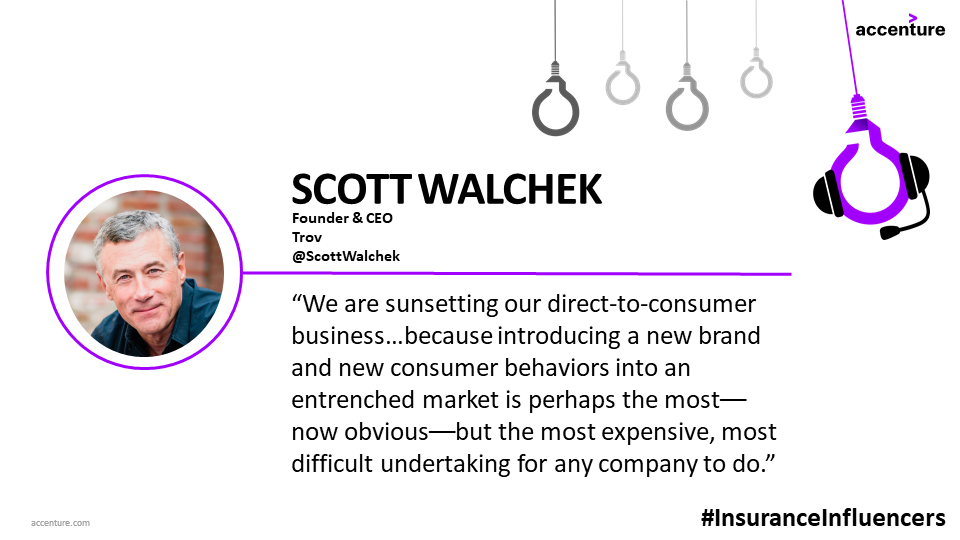
So first of all, we have decided our business model is B2B and a B2B2C model. So we are sunsetting our direct-to-consumer business. Now why is that? Primarily it’s because introducing a new brand and new consumer behaviors into an entrenched market is perhaps the most––now obvious––but the most expensive, most difficult undertaking for any company to do.
And compounding that is the inherent consumer relationship with insurers, which is built on trust, and trust is earned over years. So introducing a new brand inside an entrenched, if you would, “trust industry” is even made more difficult than if it were just a consumer product undertaking. New brand, new behavior so the CAC [consumer acquisition cost] risk is exceptionally high.
If you take that and our proposition, which was: protect your smartwatch for the times that you think is worth it, or expensive camera gear, the unit economics proved out to be unsupportable for us, even at scale. To capture an individual, to train them to engage in insurance at times that they felt that they needed to—that was a proposition that now, in hindsight, was evident that it was going to be fraught.
The unit economics were maybe, “I protect my watch or something else that’s valuable, for a day.” It’s 31 cents of gross written premium. Even if I keep it on for a week, maybe there’s $1.50 of GWP. And maybe then I break it and now we have a loss of $500 or whatever it might be. You can see that the economics would be upside down, but we didn’t know and I don’t think anybody knew. In fact, no one had ever applied on-demand of micro-duration insurance to single items. Again it was the valuable underpinnings that are now seeing life in other risks.
But so the first thing was, how do we offload CAC? How do we offload that enormous consumer acquisition cost that was essentially the same as attracting someone to a bigger risk––call it homeowner’s, auto, renters, whatever––that’s going to be the same cost to attract someone to this on-demand micro-duration insurance. So first, how do we do that?
The second is, what about taking the balance sheet risk? We’ve always said that we didn’t want to take balance sheet risk. We didn’t want to go through the process of being an insurer––a full-stack insurer–– so we took a very light regulatory authority in Australia and United Kingdom and took a little heavier authority in the United States. And that is actually years of learning about: the more regulatory authority you carry, the closer you are to the risk taking, the more control you have of the user experience.
So we’ve decided that we will live what we call “in the filet of the revenue/GWP stack.” We will either offload consumer acquisition costs to incumbents that already have 30 million monthly active users and have built the trust over years, and they can take our products powered by Trov model––take our product to their consumers. Or we’re just going to have our technology embedded with capacity behind it, embedded into the consumer platforms that already have a following of loyal consumers, and then offloading the CAC risks to that.
And at the same time, we’re going to take a higher degree of regulatory authority, still offloading the ultimate balance sheet risk to incumbents or to carriers, like an MGA. But moving further towards a little heavier regulatory authority, so that we can control more of the user experience along the path. That make sense?
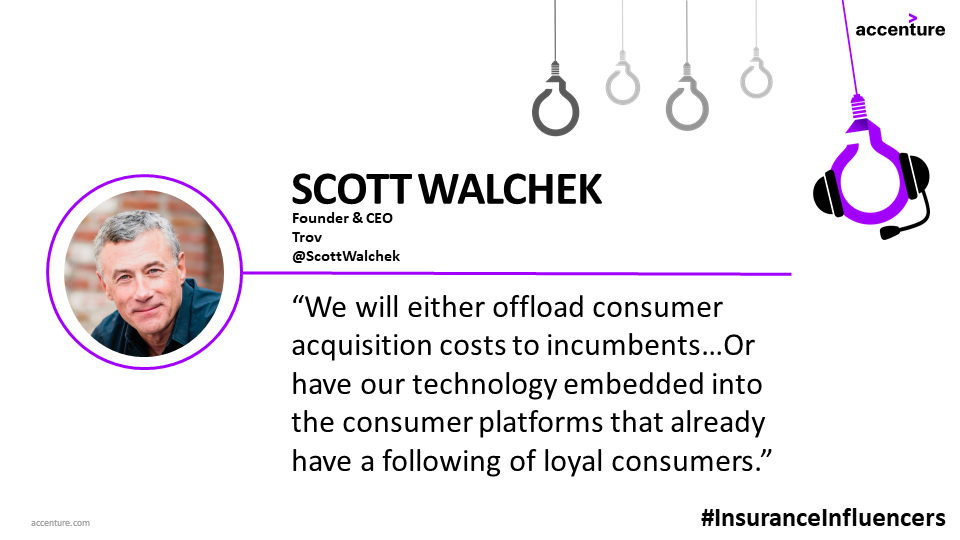
That definitely makes sense and I’m marveling at the willingness to pivot after a fairly public launch of on-demand as a direct-to-consumer offer. What is in the anatomy of Trov, that you were able to really look at it and say, “Hey this isn’t working,” and in the meantime to have built up these other capabilities and say “Well, actually here’s the opportunity.” Can you talk a little bit about that process?
Yeah. Great question, actually. It’s both what’s the word, labyrinthine. It’s very non-linear and I wish I could say that we knew at all the time, but we didn’t. We introduced the category of on-demand insurance and it’s actually a real category which makes us super proud, but the application of on-demand is actually being seen in different ways.
So the way we process it is, of course, a lot of disappointment internally. In the fabric of Trov is the idea that with anything new, where you started off will almost never be where you end.
This is now my sixth or so startup and I can tell story after story, each one of them, where we said it was going to be this and we ended up here. And they are in some cases not even in the same universe.
One story is, we started a company in 19––oh, I hate to say it––1996, building a push content platform, in the early days of the Internet that would push branded content to a subscriber base. Within four months of me raising money for what was basically a model that was subsumed by Internet Explorer 4.0, I had to literally turn to my VCs––at the time it was John Fisher and Tim Draper––and tell them, “Look, what we invested in isn’t what we’re going to do.”
And about three months later, came up with the idea around a shopping search technology platform, which became the most popular shopping search technology platform that was later sold for significant upside for all my investors. But it wasn’t even the same universe, where we started and where we ended.
That’s not the case for Trov. Trov started off disrupting insurance. It started off, actually, in disrupting the management of information about things and then turned to insurance as its first instance of how that might be manifest, and then through the last three years experiencing disappointment, watching the growth not go where we wanted, certainly watching the underwriting performance not be in the position we wanted.
Recognizing, however, that the world was changing around us, that the new ways of people live, work and move, are presenting essentially the same thing, which are these micro-sized, infinitely variable episodes of risk––which is really the same thing as on-demand micro-duration. Instead of on-demand with a human, it’s on-demand with a machine or a computer-to-computer. And that became, “Oh wow.”
And then, of course, I gave you the story about Waymo, and then others that have come to us and said, “Can you do the same thing across multiple different categories of risk?”
And it’s now become, we think, a really, really solid business model for us. And it really is that ability to encourage your 90 people who are putting their heart and soul into one direction. Being really clear and transparent about, here’s where we started, here’s where the opportunity exists and here’s how we’re going to have to pivot. Making certain that people feel appreciated and valuing the input that they gave before, but then also giving them a lot of encouragement about a future that holds true for them, for what they’ve invested in.
That’s great. The culture piece is an important one as well.
You’ve mentioned that you had this big meeting in 2016, you had five audacious goals, which turned out to be six. And it strikes me that Trov is very much a data-informed company. How do you prioritize all the information that’s coming in, discern among the opportunities that I’m sure people are saying, “Hey, why don’t you try this with the huge trove of data––pardon the pun––that you must have at your disposal.” How are you making sense of this and prioritizing and finding a way forward?
Yeah, so two questions: one about data and what data means for us. Obviously, insurance is the world’s oldest and largest big data play. And I think the first thing that data does for us, is allow us to recognize the changes of state in a user or a vehicle’s risk, data gives us that opportunity to be moved from simply reducing risk or being able to price risk, to actually moving to being risk predictors.
And I think that’s a trend that’s super important for us, where we are being very cognizant about how we build and how we capture the data. In fact, for those that take our full-stack products to market, we require that we get the anonymous data so that we can inform our models––to support, of course, better pricing, but also then start to build models that help our partners be better risk mitigators, better risk managers and better risk predictors.
So you’re 100% right that more and more data is moving to the core of how we’re building our products and how we’re providing value for our partners.
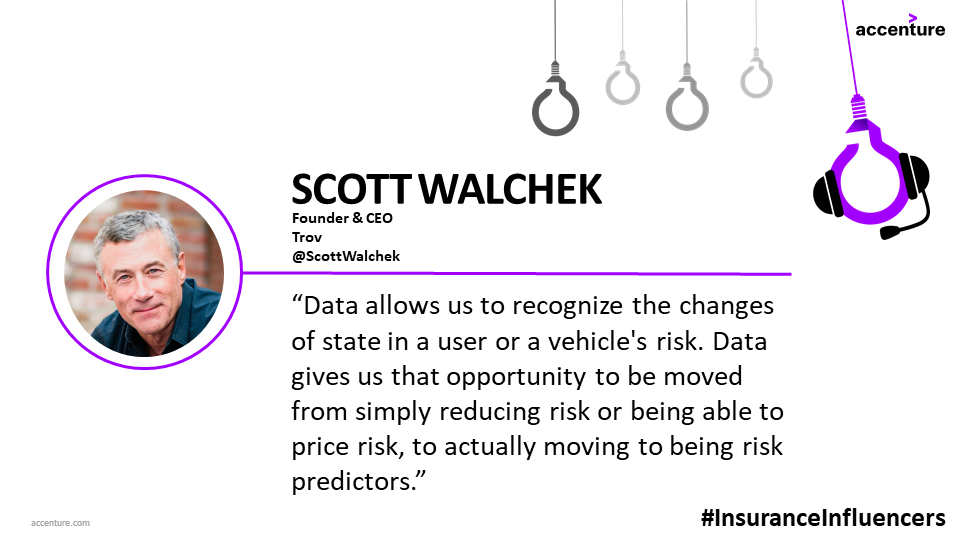
The other part of that question was how we are prioritizing. That’s actually fairly simple. We’ve raised $114 million. So I like to say we have a 114 million reasons for us to be a profitable enterprise. Finding the right model to achieve that in a reasonable amount of time, that helps us choose priorities.
So a great example would be, we have this terrific relationship with Waymo. They are by far the world’s recognized leader in autonomous vehicle (AV) operating systems and capabilities. They’ve just recently announced their expansion with Nissan and Renault around the world. Our opportunity with them is to continue to grow, as they grow in the US and elsewhere and as they expand with others. That relationship allows us then to be formidable within the emerging world of a AV.
A priority for Trov would be to build the capability, build the brand awareness, build the relationships where we can in fact be central, be core in the world of connected fleets. Be core—actually we say “win” the future of autonomous vehicle protections—whether that be for the hardware itself or for the passengers within it. Right now we’re just the passengers.
So we think that that helps us prioritize. It gives us a narrative about, “How do we make that one decision over another?” and as you said, and you’re absolutely right, we’re getting probably 30 or 40 opportunities coming to us of varying sizes. Again, many of these are very new. For example Waymo––obviously I can’t talk about what value they’re bringing us and what have you––but certainly their exponential growth is still well ahead of them, maybe a few years out if not further, which means we have to invest in the relationship and the technologies and embedding. They have over 100 people trained in using our capabilities today.
That’s an investment because the payoff right now isn’t equal to the investment we’re making. I say that relationship with them is fantastic and it’s going to, over time, be terrific for us. But the investment is that we really have to have a vision for the future, what we can own based on our current capabilities. That helps us decide about how one thing is more important than another.
That’s great Scott. Thank you. So what I’m getting is that Trov started in one place, ended up in another and that we can expect a lot more out of the company.
We call these micro-pivots. We still are a big data play, we’re still bringing the value of a unique user engagement around these micro-moments of protection. How it’s being manifest is either within someone else’s user journey or within our full-stack user journey that’s taken to market under another person’s brand. I think that’s so critical to our story today.
Scott, this has been such an interesting conversation. Thank you so much for taking the time to share your thoughts with us.
My delight. Thank you.
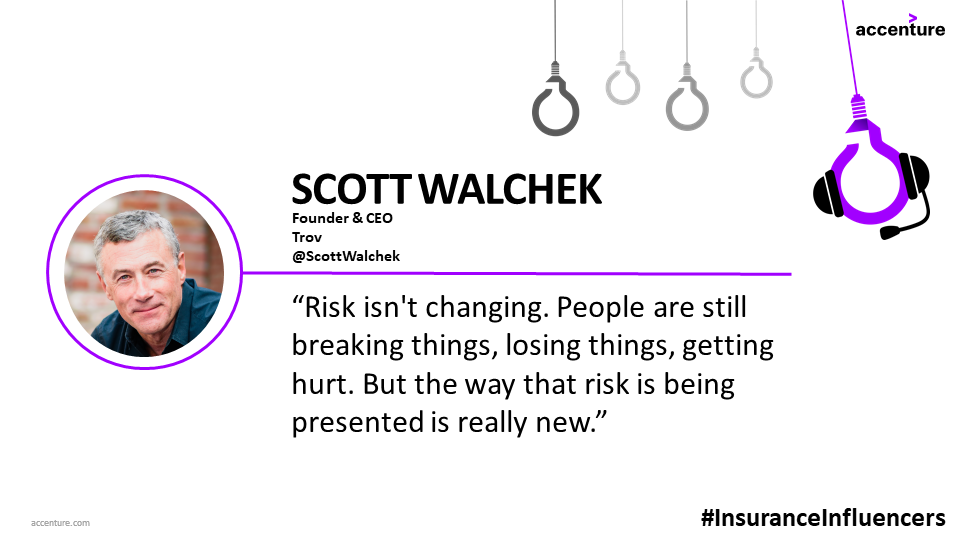
Summary
In this episode of the Accenture Insurance Influencers podcast, we talked about:
- How Trov has atomized the insurance value chain, and developed an infrastructure that enables it to cover “infinitely variable episodes of risk” that are turned on by machines, data sources and connected objects.
- The difference between new risk and known risk, and how Trov’s capabilities enable it to provide more dynamic pricing and risk management, in addition to traditional vectors like frequency and severity of risk.
- The importance of data, decisive leadership—and a good dose of serendipity—in Trov’s ability to make graceful pivots.
For more guidance on innovation:
Join us in two weeks as we share an interview with Caribou Honig, the co-founder and chairman of InsureTech Connect (ITC). We’ll be looking at trends in insurtech and get a preview of what to expect at ITC 2019. In the meantime, catch up with season one of the podcast, including topics like self-driving cars, artificial intelligence (AI), anti-fraud technology, and innovation and inclusion.
What to do next:
Contact us if you’d like to be a guest on the Insurance Influencers podcast.